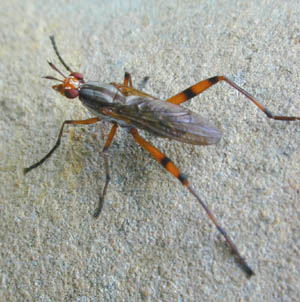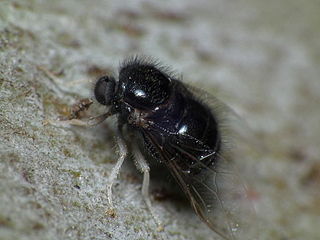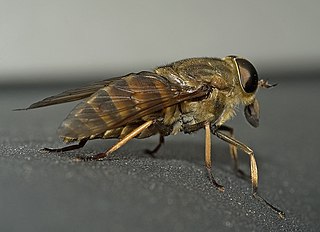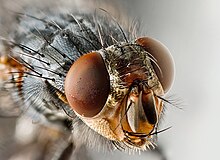
The Heteroptera are a group of about 40,000 species of insects in the order Hemiptera. They are sometimes called "true bugs", though that name more commonly refers to the Hemiptera as a whole. "Typical bugs" might be used as a more unequivocal alternative, since the heteropterans are most consistently and universally termed "bugs" among the Hemiptera. "Heteroptera" is Greek for "different wings": most species have forewings with both membranous and hardened portions ; members of the primitive sub-group Enicocephalomorpha have completely membranous wings.

The Decapoda or decapods is a large order of crustaceans within the class Malacostraca, and includes crabs, lobsters, crayfish, shrimp, and prawns. Most decapods are scavengers. The order is estimated to contain nearly 15,000 extant species in around 2,700 genera, with around 3,300 fossil species. Nearly half of these species are crabs, with the shrimp and Anomura including hermit crabs, king crabs, porcelain crabs, squat lobsters making up the bulk of the remainder. The earliest fossils of the group date to the Devonian.

The Bibionomorpha are an infraorder of the suborder Nematocera. One of its constituent families, the Anisopodidae, is the presumed sister taxon to the entire suborder Brachycera. Several of the remaining families in the infraorder are former subfamilies of the Mycetophilidae, which has been recently subdivided. The family Axymyiidae has recently been removed from the Bibionomorpha to its own infraorder Axymyiomorpha.
Orthorrhapha is a circumscriptional name which historically was used in entomology for an infraorder of Brachycera, one of the two suborders into which the order Diptera, the flies, are divided. As the group was paraphyletic, it has not been used in classifications in the last decade, and is effectively obsolete. However, many catalogs, checklists, and older works still contain the name. The taxa that used to be in the Orthorrhapha now comprise all of the infraorders in Brachycera excluding the Muscomorpha.

Cyclorrhapha is an unranked taxon within the infraorder Muscomorpha. They are called "Cyclorrhapha" with reference to the circular aperture through which the adult escapes the puparium. This is a circumscriptional name that has significant historical familiarity, but in the present classification, this name is synonymous with the more recent "Muscomorpha".

The Aschiza are a section of the Brachycera. Two large families, the Syrphidae and the Phoridae, and a number of smaller taxa are in this group. They are similar to most of the familiar Muscomorpha with one notable exception; they do not possess a ptilinum, so lack the prominent ptilinal suture on the face as in other muscoid flies. They do still have a puparium with a circular emergence opening, but it is not as precisely ellipsoid in shape as is typical for other muscoids. The term was first used by Eduard Becher.

The Acalyptratae or Acalyptrata are a subsection of the Schizophora, which are a section of the order Diptera, the "true flies". In various contexts the Acalyptratae also are referred to informally as the acalyptrate muscoids, or acalyptrates, as opposed to the Calyptratae. All forms of the name refer to the lack of calypters in the members of this subsection of flies. An alternative name, Acalypterae is current, though in minority usage. It was first used by Pierre-Justin-Marie Macquart in 1835 for a section of his tribe Muscides; he used it to refer to all acalyptrates plus scathophagids and phorids, but excluding Conopidae.

Calyptratae is a subsection of Schizophora in the insect order Diptera, commonly referred to as the calyptrate muscoids. It consists of those flies which possess a calypter that covers the halteres, among which are some of the most familiar of all flies, such as the house fly.

The Asiloidea comprise a very large superfamily insects in the order Diptera, the true flies. It has a cosmopolitan distribution, occurring worldwide. It includes the family Bombyliidae, the bee flies, which are parasitoids, and the Asilidae, the robber flies, which are predators of other insects.

The Acroceridae are a small family of odd-looking flies. They have a hump-backed appearance with a strikingly small head, generally with a long proboscis for accessing nectar. They are rare and not widely known. The most frequently applied common names are small-headed flies or hunch-back flies. Many are bee or wasp mimics. Because they are parasitoids of spiders, they also are sometimes known as spider flies.

The Brachyceran infraorder Tabanomorpha is a small group that consists primarily of two large families, the Tabanidae and Rhagionidae, and an assortment of very small affiliated families, most of which have been included within the Rhagionidae.

The Brachyceran family Vermileonidae is a small family of uncertain affinities and unusual biology. It includes fewer than 80 described species, most of them rare and with restricted distribution, in 11 genera. Historically the vermileonids had been regarded as belonging to the family Rhagionidae, possibly in a subfamily Vermileoninae. Their biology and morphology are so markedly distinct from the main Rhagionidae sensu stricto however, that the placement as a separate family has been widely accepted.

The Brachyceran infraorder Asilomorpha is a large and diverse group of flies, containing the bulk of the nonmuscoid Brachycera. The larvae of asilomorphs are extremely diverse in habits, as well.

The Empidoidea are a large monophyletic superfamily of true flies, the sister taxon to the Muscomorpha (Cyclorrhapha). These two groups are sometimes united in the unranked taxon Eremoneura. There are some 10,000 known species within Empidoidea, which are represented on all continents except Antarctica. They are known to have existed since the Jurassic period.

Nemestrinoidea is a small, monophyletic superfamily of flies, whose relationship to the other Brachycera is uncertain; they are sometimes grouped with the Tabanomorpha rather than the Asilomorpha. They are presently considered to be the sister taxon to the Asiloidea. The group contains two very small extant families, the Acroceridae and Nemestrinidae, both of which occur worldwide but contain only small numbers of rare species. One extinct family, Rhagionemestriidae, is also included in Nemestrinoidea.

Empididae is a family of flies with over 3,000 described species occurring worldwide in all the biogeographic realms but the majority are found in the Holarctic. They are mainly predatory flies like most of their relatives in the Empidoidea, and exhibit a wide range of forms but are generally small to medium-sized, non-metallic and rather bristly.

Atelestidae is a family of flies in the superfamily Empidoidea. The four genera were placed in a separate family in 1983; they were formerly either in Platypezidae or considered incertae sedis. While they are doubtless the most basal of the living Empidoidea, the monophyly of the family is not fully proven. The genus Nemedina seems to represent a most ancient lineage among the entire superfamily, while Meghyperus is probably not monophyletic in its present delimitation, and it is liable to be split up eventually, with some species being placed elsewhere. In 2010, the genus Alavesia, previously only known from Cretaceous fossils, was found alive in Namibia, subsequent species were also described from Brazil.
Apystomyia is a genus of flies in the family Apystomyiidae. The genus contains the single living Apystomyiidae species, Apystomyia elinguis, which is primarily found in California. Details of its life history are largely unknown. The extinct genus Hilarimorphites is known from the Cretaceous Burmese and New Jersey ambers. Formerly placed in the Asiloidea, molecular phylogenetic studies in 2010 placed the genus unambiguously as a sister of the Cyclorrhapha within the clade Eremoneura.

Apystomyiidae is a small family of flies containing the living genus Apystomyia and the extinct genera Apystomimus and Hilarimorphites. The single living Apystomyiidae species, Apystomyia elinguis, is native to California. Species of Hilarimorphites have been described from Mid to late Cretaceous Burmese and New Jersey ambers, while the single Apystomimus species is from the Late Jurassic of Kazakhstan.
Eremoneura is a clade of flies within the Brachycera that includes the Empidoidea and the Cyclorrhapha and is a sister of the Asilomorpha. They are thought to have evolved around the Mesozoic. The group includes fossils described in the genus Chimeromyia from 125 million year old amber which show both empidoid and cyclorrhaphan characters. The monotypic family Apystomyiidae has also been placed within the Eremoneura as a sister of the Cyclorrhapha.

















